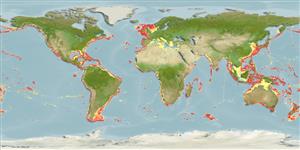Classification / Names
Common names from other countries
Main reference
Size / Weight / Age
Max length : 445 cm TL male/unsexed; (Ref. 106604); common length : 270 cm TL male/unsexed; (Ref. 5217); max. published weight: 505.8 kg (Ref. 4699); max. reported age: 32 years (Ref. 86588)
Length at first maturity
Lm 277.5, range 275 - 285 cm
Environment
Marine; pelagic-oceanic; oceanodromous (Ref. 51243); depth range 0 - 750 m (Ref. 106604), usually 100 - 150 m (Ref. 36731)
Climate / Range
Subtropical; 16°C - ? (Ref. 9988), preferred 26°C (Ref. 107945); 61°N - 56°S, 180°W - 180°E
Distribution
Cosmopolitan in temperate and tropical seas (Ref. 6871, 11230). Western Atlantic: Gulf of Maine to southern Brazil and Argentina (Ref. 58839), including the Gulf of Mexico and Caribbean. Eastern Atlantic: Norway to South Africa, including the Mediterranean. Indo-Pacific: East Africa to Hawaii, north to Primorskiy Kray (Russian Federation), south to Australia and New Zealand. Eastern Pacific: south of Aleutian Islands and from southern California, USA to Chile.
Countries | FAO areas | Ecosystems | Occurrences | Introductions
Short description
Dorsal
spines
(total): 0;
Dorsal
soft rays
(total): 0;
Anal
spines: 0;
Anal
soft rays: 0. A large, spindle-shaped shark with large black eyes, a sharp snout, and large, narrow, hooked teeth with smooth edges (Ref. 5578). Caudal fin lunate, lower lobe strongly developed (Ref. 13574). Dark blue above, white below (Ref. 6581). Tiny second dorsal and anal fins (Ref. 26938).
IUCN Red List Status (Ref. 115185)
Human uses
Fisheries: minor commercial; gamefish: yes
Tools
Special reports
Download XML
Internet sources
Estimates of some properties based on models
Phylogenetic diversity index
PD50 = 0.7813 many relatives (e.g. carps) 0.5 - 2.0 few relatives (e.g. lungfishes)
Trophic Level
4.5 ±0.0 se; Based on diet studies.
Resilience
Very Low, minimum population doubling time more than 14 years (rm=0.051; K=0.2; tmax=28; tm=20; Fec=4)
Vulnerability
Very high vulnerability (83 of 100)
Price category
